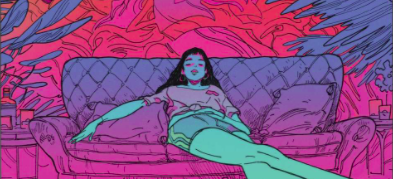The Many Deaths of Laila Starr #3 // Review
Death has a cigarette. There’s a conversation. The kid who will go one to invent immortality is working at a pillow factory. He’s learning about the ephemeral nature of life. She doesn’t know who he is. They say it’s the one time she’s ever going to meet him, but time will tell as writer Ram V moves through the middle chapter of The Many Deaths of Laila Starr. Artist Filipe Andrade carves elegant visuals around the poetry of Ram V’s script. Another fleeting moment in the lives of death’s avatar glides by like a smoky, billowing dream, ushering in the final couple of issues of the series.
The boy who would grow up to invent immortality is working in a pillow factory. They don’t just make pillows there. They make dreams. And while this might not actually be literal, it IS symbolic of what the young man is going through. He’s being dumped by a woman who might be his first real love. Things aren’t going to end well, but for the moment, he’s sharing a cigarette at a party with a woman known as Laila Starr. She doesn’t know who he is. He doesn’t know who she is. It’s a chance meeting at a party mid-way through the series.
The way Ram V tells the story...the poetry is way too easy. A man who will invent immortality is working at a pillow factory as he loses his first real dream. It goes up in smoke, and death is there, but she doesn’t know it, and she doesn’t know that she’s going to die again. The beauty of the overall series continues as the many years between issues guide the title character through a moody, listless journey to try to save her job. It’s all quite beautiful.
Andrade captures some of the beauty of the story and brings it to the page with dreamy cloudiness. The smoke and fire that permeate this issue are cast in the same dreamy color that the rest of the series has been host to. Deep pinks and purples wash over everything. There’s a pretty pastel that accompanies fire, smoke, and ash in the midst of a story of loss and hope. The drama has a beautiful stagnation about it that Andrade puts to page with a kind of still silence that seems to exist on an entirely different track from all the dialogue and narration. The script and the art seem to be dancing very closely--each animating the other.
Laila Starr is the main character here, but it’s really he who will invent immortality, who is the center of the story. There’s a nice sense of duality between story and art and death and the man who will make it obsolete. Laila has lost much of the direction she seemed to have in the first couple of issues. It’ll be interesting to see what kind of momentum V and Andrade can summon for her in the last couple of installments of the series.










